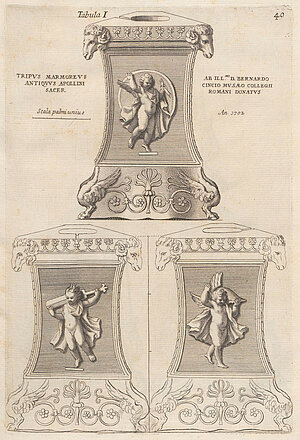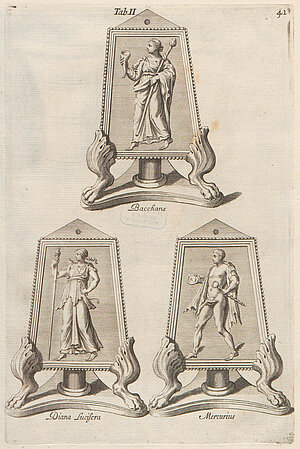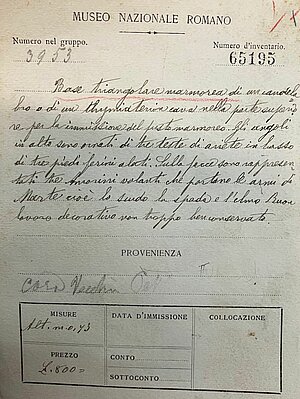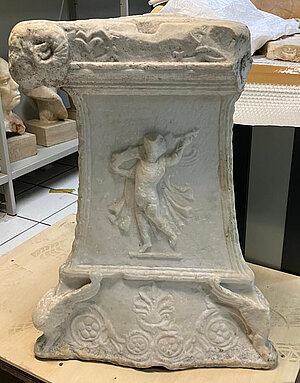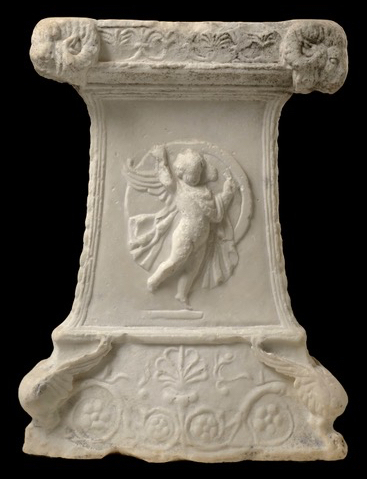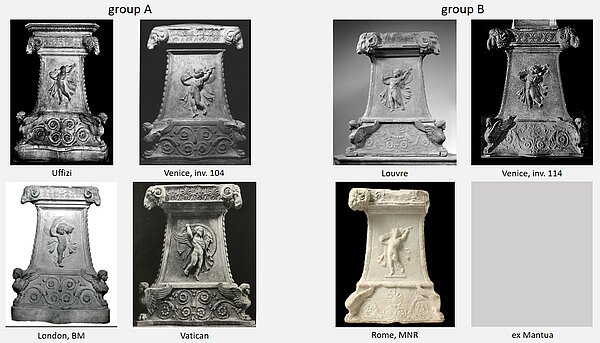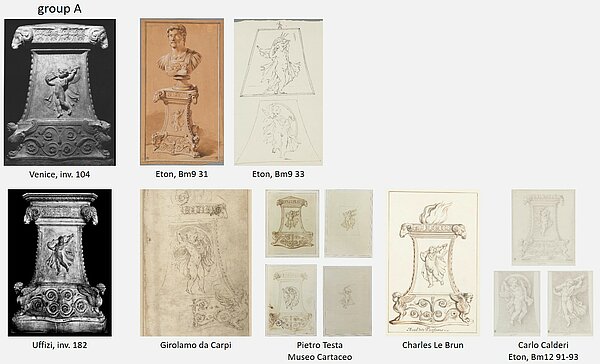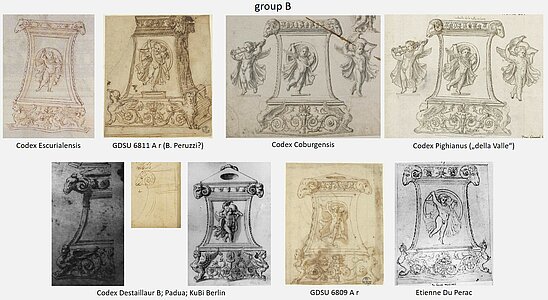#8: Cupids – stolen, lost and refound
Elena Vaiani
Version of the article suitable for citation
on ART-Dok (Heidelberg University Library)
DOI: https://doi.org/10.11588/artdok.00009824
The first plate in Filippo Bonanni’s Musaeum Kircherianum reproduces what he classifies as a ‘tripos marmoreus antiquus Apollini sacrum’, actually a triangular candelabrum base, decorated on each side with a cupid bearing a different weapon of Mars (shield, helmet, and sword). In the upper part, the corners of the base are in the form of ram’s heads, in the lower part in the form of winged sphinxes (the latter are all missing their heads); in addition, acanthus scroll motifs, palmettes, and rosettes decorate the marble (fig. 1).
Bonanni's catalog, published in 1709, illustrates antiquities, scientific objects, and exotic finds preserved at the Collegio Romano, the legacy of the extraordinary museum assembled by Athanasius Kircher, who had arrived in Rome in 1633. The collection had grown over the years thanks to Kircher's research in science and through an important donation by Alfonso Donnino (1651), which included mainly ancient objects; in 1678, Giorgio de Sepibus published a description of the museum in Amsterdam. However, as Bonanni writes in the introduction to his catalog, after Kircher’s death, the Museum was in danger of going the way of so many other collections–such as those of Giovan Pietro Bellori or Pietro Stefanoni, for example, sold abroad or dispersed–, so that little would remain of what had been one of the most celebrated collections of the 17th century. It was Bonanni himself, who from 1698 undertook to ‘save’ the Museum. The most obvious results were the relocation from the ground floor to the third floor in the Collegio Romano, important purchases for the collection, and precisely the publication of the catalog. [1]
The choice to open the catalog with the image of the candelabrum base is a sign of the museum’s new life. Visitors would enter it from the vestibule, where the marble sculptures found their place, among which was likely to be this one, which, as Bonanni’s captions on the engraving attest, was a recent acquisition. It was the brothers Bernardo (1662–1732) and Cesare (1664–1729) Cenci, canons of San Giovanni in Laterano, who donated it in 1702.
The second plate also reiterates this ‘new course’ for the museum. A similar object is reproduced there, this time correctly identified by Bonanni as a candelabrum base. It depicts Minerva, Mercury and a Bacchante and was found in 1708, shortly before the publication of the catalog, at the church of San Sisto vecchio on the Via Appia (fig. 2). [2] These two objects thus introduce the virtual visitor – we would say today – to a museum that Bonanni proposes as alive and dynamic, dialoguing with contemporary scholarship, and whose integrity the Jesuit father himself would undertake to ensure, and which would be maintained until the 20th century.
Next to each other in Bonanni's book – probably also next to each other in his new arrangement of the Museum–the two candelabrum bases separate not long after 1709. While that of the first plate remains in Rome, the second was acquired by Pierre Crozat (1661–1740), the greatest collector of his century. Crozat was in Italy as early as 1714 on behalf of the Regent, Philip II d'Orléans, but we do not know when exactly the tripod arrived in France from Rome. What is certain is that in 1757 an engraving depicts it in Caylus’ Recueil d'antiquités and it is now in the Cabinet des Médailles in Paris. [3]
Meanwhile, the ‘tripod’ of plate I remained in Rome until the early twentieth century before vanishing into thin air, so much so that Bonanni’s engraving was for more than two centuries the only available image of the sculpture, of which there is no published photographs until the entire twentieth century. What did happen?
As is well known, after 1870, with the conquest of Rome by the Italian army, precisely the Museo Kircheriano (henceforth Kircheriano) was the only state museum (since 1873) in the new capital, which had been preserved and enriched steadily from the time of Bonanni onward. From this collection, the project of a large state museum of antiquities in Rome was born, what is now the Museo Nazionale Romano, of which the antiquities preserved in the rooms of the Collegio Romano thus constitute the founding nucleus. [4] To give an idea of the size of the collection: the antiquities from the Kircheriano today at the Museo Nazionale Romano amount to, by rough approximation, about 10,000 out of about 60,000 objects.
The Kircheriano as such ceased to exist in 1913: by that date, all the artifacts had been gradually transferred to the Baths of Diocletian and various other museums that had sprung up in the post-unification period. Our candelabrum base was no exception. It left the Collegio Romano to be placed on the premises of the Baths with the inventory number 65195, but curiously without any indication of its provenance from the Kircheriano on the inventory’s index card (fig. 3). [5] It had to be part of the last lots of antiquities to leave the old location. 1912 it is described in the third edition of Helbig’s Führer as still at the Collegio Romano, then in the Baths’ museum in Paribeni’s catalog eight years later, in 1920. [6]
At some unspecified moment, however, this 73 cm high marble sculpture of considerable weight dissolves into thin air. In the fourth edition of Helbig’s guide (1972) the base is said to be “nicht ausgestellt” (not on display). In his seminal catalog on Roman candelabrum bases (1985), Hans-Ulrich Cain points out that the base could not be found yet in 1977, 1978, and 1980, and thus indicates it as lost at least since 1972. [7] The base thus disappears from the museum and the bibliography. [8]
During the cataloging of the Musaeum Kircherianum for the project Antiquitatum Thesaurus, as a result, the candelabrum base was initially considered lost, as in all studies from 1972 onward. However, a verification initiated with the staff of the Museo Nazionale Romano reconstructed that the base had been recovered by the Carabinieri on the antiques market, and was exhibited in 2014 in the exhibition La memoria ritrovata, at the Palazzo del Quirinale. [9] After the exhibition, the base returned to the Museo Nazionale Romano, but no longer in the buildings of the Baths of Diocletian and no longer on display, rather kept in the portrait storage room (magazzino ritratti) of the Palazzo Massimo (fig. 4).
After at least forty years, then, this sculpture has ideally regained its place among the Kircher’s antiquities, but not only that. We are finally able to compare it with other bases, which have similar measurements and decorations. It is in fact an example of mass production of sculptures, probably made for the decoration of residences of high-ranking dignitaries. Early-modern authors have speculated that Kircher’s base had been found at Hadrian’s Villa, along with two others, one in London (British Museum) from the Townley collection and the other in the Vatican. [10] In addition to these, five other bases are known, in Florence (Uffizi) – from the Villa Medici (possibly from the Della Valle collection) –, in the Louvre, two in Venice and a fragmentary one in Mantua, now lost. [11]
Compared to the other six bases that have come down to us, ‘ours’, as already pointed out in the inventory index card of the Museo Nazionale Romano, is not in the best state of preservation. The details of the faces of the cupids are barely visible and all the heads of the sphinxes in the lower part are missing; the right foot of the Cupid with shield is lost. Compared with Bonanni’s engraving and the inventory card of the Museo Nazionale Romano, moreover, one of the ram heads at the top is missing, a damage that presumably occurred during the period of its ‘absence’ from the Museum (fig. 5). [12]
The decoration of the lower zone with the volutes arranged on a single line at the bottom and not on two registers, brings the base closer not to the specimens believed to have been found at Hadrian's Villa, but rather to those in the Louvre and Venice (inv. 114), which are also united by the presence of a small base line on which the three cupids rest. Just as Orietta Vasori and Hans-Ulrich Cain have done before, the various replicas can thus be distinguished into two groups: group A (Uffizi, British Museum, Vatican, Venice inv. 104) and group B (Louvre, Museo Nazionale Romano, Venice inv. 114, Mantua) (fig. 6). [13]
Having tracked down this specimen as well, having completed the series of currently known bases with these figurations, all coming from historical collections, and thus being able to distinguish on the originals the details of individual exemplars may perhaps help in solving a kind of rebus, which concerns the iconographic tradition of these marbles. While recent images of our base seem to be particularly rare, there have been numerous reproductions of this series of objects in early modern times.
In fact, several drawings are known from the mid-sixteenth century onward depicting our ‘armed’ cupids. However, since these bases are serial products, i.e. objects that are very similar to each other, it is not always possible to tell what object exactly is portrayed in the drawings. This is a constant problem when dealing with this kind of production. Apart from sculptures like as these, similar cases occur for objects of small format – such as small bronzes, terracottas etc.–, replicated in large quantities (just as coins, fibulae, oil lamps). Often in such cases one has many replicas of objects, hardly all of which are known today, and a relatively small number of drawings. Our’s is a particular, yet not unique example of a complex and rich iconographic tradition involving a fairly small and controlled corpus of antiquities. Still, there is no shortage of difficulties, as the related records in the Census of Antique Works of Art and Architecture Known in the Renaissance warn.
Nevertheless, there are a few fixed points (fig. 7). Three anonymous eighteenth-century drawings at Eton College reproduce one of the two Venetian 'tripods,' inv. 104. The most 'finished' and detailed drawing reproduces the base in its entirety, revealing that a possibly non-antique bust of Emperor Hadrian was placed on it; the other two are rush-made records of the other sides. [14] The specimen now in the Uffizi, but until 1756 at the Villa Medici in Rome, is explicitly mentioned instead in the drawings by Carlo Calderi (also at Eton, c. 1710–1730). [15] The Medici base is also referred to in the four drawings by Pietro Testa in the Museo Cartaceo of Cassiano dal Pozzo, executed in the first half of the 17th century (again, with varying degrees of quality). [16] In discussing the graphic tradition of the Florentine base, Amanda Claridge and Eloisa Dodero also recognize one side of it in the seventeenth-century drawing by Charles Le Brun and in one, about a century earlier, by Girolamo da Carpi. [17] All these drawings and specimens belong therefore to group A.
An anonymous drawing in the Uffizi, also dated to the mid-sixteenth century and published by Orietta Vasori in 1978, was instead referred to the Venetian base inv. 114, from group B. [18] According to the above criteria, the following drawings known to date can now also be assigned to the same group B (fig. 8):
- Codex Escurialensis. [19]
- a sheet at the Uffizi (2nd quarter of the 16th century, attributed to Baldassarre Peruzzi). [20]
- an anonymous drawing in Berlin (mid-16th century), in which the cupid with helmet is reproduced, without the small base line; the inscription Pellestrina di marmore indicates a provenance not recognized at present for any of the known bases. [21]
- Codex Destailleur B in St. Petersburg, shown in the Census as a parallel copy of the drawing in Berlin, depicting only the profile of the base, with the ram’s head and the sphinx, but with no cupid; an anonymous copy of this drawing is in the Padua library. [22]
- Codex Coburgensis (1550–1555), with the sphinx’s heads missing as in the base of the Kircheriano. [23]
- Codex Pighianus (1550–1555), copied after the Codex Coburgensis. The annotation, only preserved in the Pighianus, locates the piece in the Della Valle collection. But, as Claridge and Dodero have already excluded both drawings as documents of the base at the Uffizi because of the differing decorations, [24] this piece cannot have passed through Villa Medici to Florence, as so many other marbles have.
- a drawing by Etienne Du Perac in Paris (mid-16th century), also already excluded by Claridge and Dodero in relation to the base at the Uffizi. [25]
More difficult, however, to place the drawing by Amico Aspertini (c. 1540): it depicts only the cupid with the sword as an independent figure, while the base is not shown. [26]
In the text referring to his plate no. 1, Bonanni says that Kircher’s candelabrum base had been in the Cenci brothers’ collection for many, many years: perhaps it was already known in the 1500s or 1600s? Or is Bonanni’s engraving really destined to remain the only image of the candelabrum base before the 21st century, along with the one that Bernard de Montfaucon drew from the Musaeum Kircherianum in 1719? [27] New studies will tell. In the meantime, research around these particular cupids, which are lost, found, and mingled among others, has initiated a collaboration between Antiquitatum Thesaurus and the Museo Nazionale Romano. The aim is to reconstruct, using Bonanni’s own catalog as a guide, that collection that the Jesuit father had so painstakingly rescued, and which had so much importance in the process that led to the establishment of the museums of ‘Roma Capitale’.
[1] F. Bonanni, Musaeum Kircherianum, Romae 1709, p. 1 (proemio) and pp. 4–7 (commentary on pl. I). For the Museo Kircheriano see: A. Bartola, Alle origini del museo del Collegio Romano. Documenti e testimonianze, in «Nuncius. Annali di Storia della Scienza», XIX, 2004, fasc. 1, pp. 297–356.
[2] H.-U. Cain, Römische Marmorkandelaber, Mayence, 1985, p. 158, no. 28, pl. 92.1 (incorrectly listed as on the antiques market in Cologne). For Bonanni's plate cf. Antiquitatum Thesaurus: https://db.antiquitatum-thesaurus.eu/object/1368135.
[3] A. C. Ph. De Caylus, Recueil D'Antiquités, Egyptiennes, Etrusques, Grecques Et Romaines, I, 1757, pl. 82.1 (https://digi.ub.uni-heidelberg.de/diglit/caylus1752bd1/0325/image,info). Paris, BnF, Cabinet des Médailles, inv. 57.44. M. Avisseau-Broustet, “Notices des documents exposés”, in Caylus mécène du roi. Collectionner les antiquités au XVIIIe siècle, Catalogue de l’exposition (Paris, Bibliothèque Nationale de France - Cabinet des Médailles, 17 décembre 2002–17 mars 2003), Paris 2002, p. 136, no. 43.
[4] Cf. S. Bruni, I musei archeologici di Roma capitale, in «Rivista dell’Istituto nazionale di Archeologia e Storia dell’Arte», s. III, 14–15, 1991–1992, pp. 379–392.
[5] "Triangular marble base of a candelabrum or thymiaterion hollow at the top for placing the marble shaft. The top corners are ornamented with three ram's heads, at the bottom with three winged feral feet. On the faces are depicted three flying cupids bearing the weapons of Mars, i.e., shield, sword, and helmet. Good decorative work not too well preserved." Location is indicated at the "old house," height 0.73m, price 800 lira.
[6] W. Helbig, Führer durch die öffentlichen Sammlungen klassischer altertümer in Rom3, 1912, II, p. 281, no. 1661. R. Paribeni, Il Museo Nazionale Romano e le Terme di Diocleziano, Rome 1920, p. 108, no. 281.
[7] Cain Römische Marmorkandelaber (note 2), p. 252, no. 50. W. Helbig, Führer durch die öffentlichen Sammlungen klassischer altertümer in Rom4, 1972, IV, p. 450, no. 1661.
[8] The base is cited–and illustrated with Bonanni– by A. Reinhardt, Reproduktion und Bild. Zur Wiederholung und Vervielfältigung von Reliefs in römischer Zeit, Wiesbaden 2019, p. 115, no. S.10* with reference to Cain and without being discussed in full precisely because of the failure to autopsy the object; pl. 46, fig. 153 (Bonanni pl. 1).
[9] La memoria ritrovata. Tesori recuperati dall’Arma dei Carabinieri, exhibition catalog (Rome, 23 January–16 March 2014), Roma 2014, p. 82, no. 30.
[10] Cain Römische Marmorkandelaber (note 2), pp. 160–161, no. 35 (London, British Museum, n. 2509, from the Townley’s collection; https://arachne.dainst.org/entity/1071087); p. 188, no. 104 (Vatican City, Galleria dei Candelabri, inv. 2677, purchased in 1790; https://arachne.dainst.org/entity/6208300).
[11] Cain Römische Marmorkandelaber (note 2), p. 155, no. 20 (Firenze, Galleria degli Uffizi, inv. 182, Capranica-Della Valle? https://database.census.de/#/detail/152873); p. 171, no. 63 (Paris, Musée du Louvre [dépôt], MA 611, from the Museo Maffeiano; https://arachne.dainst.org/entity/1107094); p. 197, no. 125 e p. 198, no. 126 (Venezia, Museo Archeologico, inv. 104 https://database.census.de/#/detail/152932 e inv. 114 https://database.census.de/#/detail/159793, from Grimani legacy); p. 201, no. 143 (formerly in Mantova, Palazzo Ducale).
[12] Cf. the record in Antiquitatum Thesaurus: https://db.antiquitatum-thesaurus.eu/object/1368134.
[13] Cain Römische Marmorkandelaber (note 2), pp. 47–59, and O. Vasori, Alcuni disegni degli Uffizi con marmi antichi, in «Prospettiva», XIV, 1978, pp. 67–73, in part. pp. 69–70.
[14] See above, note 10. Cf. Eton College Library, Bm. 9 no. 31; a note describes the object as an 'ara' and places it in the ‘Bibl. St Marci Venet.’ (https://catalogue.etoncollege.com/object-ecl-bm-9-31-2013). The other two sides of the base, only with cupids, executed with rapid pen strokes, are at no. 33 (https://catalogue.etoncollege.com/object-ecl-bm-9-33-2013).
[15] Eton College Library, Bm 12 nos. 91, 92, 93; https://catalogue.etoncollege.com/object-ecl-bm-12-91-2013, with the indication “Villa Medici”.
[16] A. Claridge, E. Dodero, The Paper Museum of Cassiano dal Pozzo. A.III. Sarcophagi and other reliefs, London 2022, II, pp. 723–728, nos. 467–470.
[17] Paris, BnF, ms. fr. 17217, fol. 56 https://gallica.bnf.fr/ark:/12148/btv1b52517132k/f133.item#; the object is identified as “autel des parfums”; Girolamo da Carpi's drawing is located in Philadelphia, Rosenbach Foundation, Carpi Album, fol. 124. https://database.census.de/#/detail/55877.
[18] Florence, Galleria degli Uffizi, GDSU, inv. 6809r https://database.census.de/#/detail/58726; cf. Vasori, Alcuni disegni degli Uffizi (note 13), p. 70, fig. 3.
[19] Biblioteca del Monastero de El Escorial, 28-II-12, fol. 49r https://database.census.de/#/detail/48806.
[20] Florence, Galleria degli Uffizi, GDSU, inv. 6811A r https://database.census.de/#/detail/48807.
[21] Berlin, Kunstbibliothek, OZ 114, fol. 26 above https://database.census.de/#/detail/244599.
[22] St. Petersburg, Hermitage, Codex Destailleur B, fol. 78r https://database.census.de/#/detail/10167885; Padua, Biblioteca Universitaria, inv. MS 764, fol. 10v https://database.census.de/#/detail/10167887.
[23] Coburg, Veste, Kupferstichkabinett der Kunstsammlungen der Veste Coburg, Hz 2, no. 100. https://database.census.de/#/detail/58725.
[24] Berlin, Staatsbibliothek, Ms. Lat. 61, fol 39r; Claridge, Dodero The Paper Museum of Cassiano dal Pozzo (note 16), p. 723 https://database.census.de/#/detail/58724.
[25] Paris, Musée du Louvre, Cabinet des dessins, inv. 26434r; Claridge, Dodero The Paper Museum of Cassiano dal Pozzo (note 16), p. 723 https://database.census.de/#/detail/65132.
[26] London, BM, Prints and drawings, Aspertini Sketchbook, fol. 30v https://database.census.de/#/detail/48728.
[27] B. de Montfaucon, L’Antiquité expliquée et représentée en Figures, Paris 1719, II.1, pl. 50. The preparatory plate of the Antiquité is located in Paris, Bibliothèque Nationale, ms. lat. 11916, fol. 98r; cfr. Antiquitatum Thesaurus: https://db.antiquitatum-thesaurus.eu/object/1708842. As mentioned, studies after the recovery of the base also considered it lost (cf. note 8). In Helbig 1972 (note 7) images of the base are cited, which are unpublished, cf. p. 517, no. 1661.

